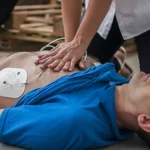Medical emergencies necessitate quick reaction times and swift decisions. When faced with an emergency, the last thing you want to do is hesitate. One of the things that can make someone hesitate in an emergency is fearing the legal repercussions of trying to help.
In the case of CPR (cardiopulmonary resuscitation), you might fear that someone can sue you for causing them injuries. For example, while performing CPR ribs get broken, broken ribs law suit can be imposed. Luckily, most states have what’s known as good Samaritan laws that protect the average person and encourage people to act in critical, life-threatening emergencies.
These laws demonstrate the government and the health care community’s commitment to saving lives with CPR. An estimated 350,000 cardiac arrests occur every year, and 90% of the cardiac arrests that occur outside of hospitals are fatal. Simply put, we need more CPR-trained professionals who can act decisively in cardiac arrest emergencies.
At the American Health Care Academy, we provide accessible, affordable CPR AED training and classes that will eliminate any doubts you have about your abilities to perform CPR. Get CPR AED certified online to control your learning pace and have access to instant certification. Enroll today and equip yourself with the tools for saving a life. How long does CPR certification last? It is valid for two years and can be renewed.
What Is CPR?
Cardiopulmonary resuscitation (CPR) is a lifesaving technique that helps victims of cardiac arrest. Cardiac arrest can be sudden or a result of underlying conditions, such as a heart attack or a near-drowning.
In cardiac arrest situations, CPR can potentially circulate the blood, maintaining the oxygen flow throughout the body. Most importantly, CPR can carry oxygen to the brain, preventing brain damage. After cardiac arrest, brain damage can occur within minutes. Death can occur within 8 to 10 minutes.
Who Can Perform CPR?
Because cardiac arrest is often fatal, the American Heart Association recommends people should perform CPR chest compressions even if they have little to no CPR experience. However, because even those with extensive CPR training online tend to perform CPR incorrectly, it’s vital to get CPR/AED certified.
No amount of training can fully prepare you for a real medical emergency, but the more training you receive, and the more frequently you refresh your skills, the more confidently you’ll respond in cardiac arrest emergencies.
Although the American Heart Association encourages everyone to perform CPR in case of emergency, how you perform CPR depends on your training level.
Untrained
Those with no formal CPR training should forego rescue breath and only perform chest compressions. They should perform hard compressions at 100-120 BPM. An easy way to conceptualize the chest compressions’ rhythm is pumping to the tune of “Staying Alive” by the Bee Gees.
Thoroughly Trained
Those formally trained in CPR will know to first check for the patient’s breath for ten seconds. If the patient doesn’t breathe, you should begin chest compressions. After performing 30 chest compressions, give the patient two rescue breaths.
Trained but Rusty
If you have training but haven’t performed CPR or received recent training for a long time, you should only perform hands only CPR.
When Should You Stop Performing CPR?
There are a few reasons to stop performing CPR. These reasons include noticing signs of a heartbeat, medical assistance arriving, or an AED being ready and available for use.
Noticing Signs of Life
Patients may show signs of life and then go back into cardiac arrest, but you should only perform CPR while the patient is in cardiac arrest. If you notice the patient is breathing or their heart is beating you should discontinue chest compressions.
Medical Assistance Arrives
If medical assistance arrives, you should finish your round of chest compressions and let them take over. Medical professionals will arrive on the scene with an AED and advanced equipment, so letting them take over can improve the victim’s survival chances.
AED On-Site
An automatic external defibrillator (AED) is more useful than chest compressions because it can measure the electrical signals in the heart and deliver a calculated voltage based on those calculations. According to a study published in the NCBI, survival rates decline by 7-10% for each minute without AED usage.
Is Bad CPR Better Than No CPR?
According to another study published in the NCBI, bad CPR has similar effects to no CPR. This statistic shouldn’t dissuade bystanders from performing CPR. If anything, it should do the opposite, and prompt people to get CPR certified.
The NCBI study showed that the primary reason for bad CPR having similar outcomes to no CPR is that people failed to perform chest compressions hard enough. Chest compressions that don’t generate enough force fail to circulate the blood.
Hand placement was another differentiator in CPR quality throughout the study. Proper hand placement includes performing chest compressions at the base of the breastbone where the ribs meet.
Common CPR Complications
The most common type of CPR complication is thoracic (chest) injury. These types of injuries can be caused by hand placement or the force of chest compressions. Although injuries are unfortunate, they are less damaging than the alternatives that can occur if someone does not perform CPR or doesn’t put enough force behind their chest compressions.
Another complication that can arise from CPR is abdominal distention. Abdominal distension results from too much air flowing into someone’s stomach. This air surplus causes bloating and results in lung compression that makes breathing more difficult.
CPR complications occur, but they are not suitable reasons to discontinue performing CPR. In any case, performing CPR is preferable to standing by and doing nothing.
Can I Have a Lawsuit Filed Against Me If I Perform CPR?
In the unfortunate event where the cardiac arrest victim experiences injury or death, you don’t have to fear legal recourse. There has never been a successful lawsuit against a layperson who gives CPR because good Samaritan laws protect bystanders against such legal actions.
How Do Good Samaritan Laws Work?
There are good Samaritan laws in all 50 states. These laws provide civilians limited immunity to anyone who performs CPR in “good faith” to save a life.
A person is a good Samaritan if:
- The rescuer tries to help.
- The rescuer’s actions are reasonable (gross misconduct voids good Samaritan laws).
- The rescuer does not receive compensation for performing CPR.
For example, let’s say you’re in a restaurant waiting for a table. The person sitting next to you goes into sudden cardiac arrest. You have no prior CPR training, but you make the ethical decision to try to save the person’s life. You perform CPR chest compressions at a 70 BPM rate to the best of your ability, but the patient passes away.
When the medical professionals arrive, they notify you that you performed CPR at the wrong rhythm. Because you performed CPR to the best of your ability, you would not be liable for any of the victim’s damages.
What Is an Advance Directive?
Advance directives are legal documents that establish the care patients consent to and reject. Advanced directives most commonly apply to people in the hospital with severe or terminal conditions.
Advance directives include the following documents:
- Living will.
- Power of attorney for health care.
- Physician orders for life-sustaining treatment.
- Do not resuscitate order (DNR).
What Is a Do Not Resuscitate Order?
Many states have DNR laws, which give people the right to refuse CPR. In all cases, you should respect the victim’s rights. Victims often wear jewelry or carry a card in their wallet or purse that signifies their DNR status.
The World Needs More People Certified In CPR
Across the globe, 17.5 million people die every year from cardiac arrest. CPR AED training can effectively double or triple patients’ survival rates. These statistics show the glaring need for more CPR certified laypeople.
There is no telling when you’ll need to be prepared for an emergency; their untimely nature and unpredictability reflect the importance of CPR and first aid training. In the words of Baz Luhrman, “the real worries are those that blindsight you at 4 pm on some idle Tuesday.”
At the American Health Care Academy, we provide self-paced online CPR AED certifications that prepare you for these types of emergencies. As a member of society, we all have to try and protect our fellow citizens. Register today to sharpen your CPR skills today.













